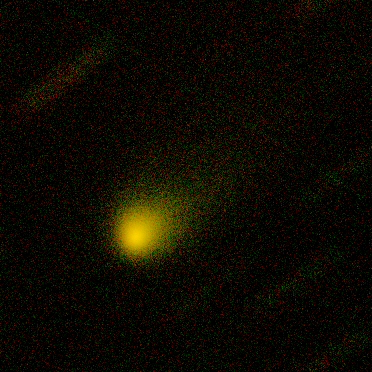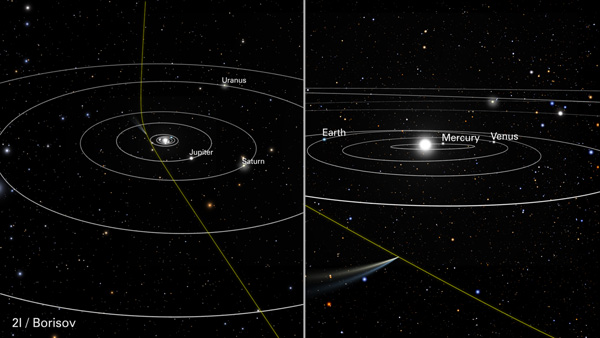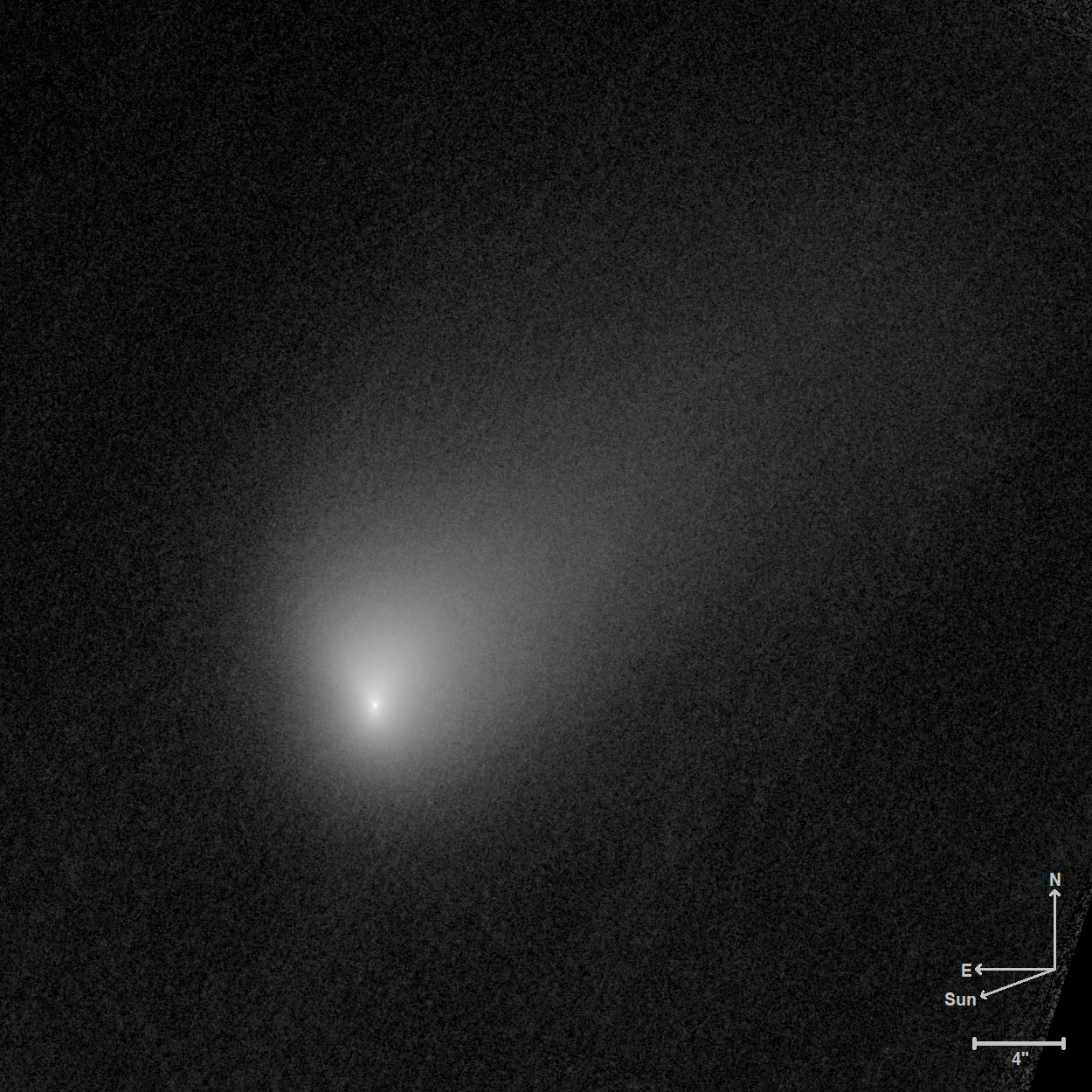Ground-based observations of interstellar comet 2I/Borisov show that it looks just like comets in the solar system.

Gemini Observatory / NSF / AURA
The solar system's newest interstellar visitor, Comet 2I/Borisov, looks remarkably familiar. A new study characterizing the comet revealed details, such as its nucleus size and gas distribution, that bear a striking resemblance to the icy population of the outer solar system.
At the end of August, amateur astronomer Gennady Borisov spotted an object moving through the sky. Subsequent observations revealed that the object’s speed and trajectory indicate an origin outside the solar system. Now officially known as Comet 2I/Borisov (C/2019 Q4), it is the second interstellar interloper ever identified by astronomers. The first interstellar visitor is called ‘Oumuamua (1I/2017 U1), but that one looked more like an asteroid than a comet. With its fuzz of a tail, Borisov takes a more familiar appearance.
"So far, Comet Borisov is indistinguishable from comets observed in our backyard, except for its orbit," says Michał Drahus (Jagiellonian University, Poland). "With its familiar properties, [Comet Borisov] tells us that comets similar to the ones we know from this solar system also form around other stars."
Drahus worked with Piotr Guzik, also at Jagiellonian, to observe the object in early September with the 8.2-meter Gemini North Telescope in Hawaii and the 4.2-meter William Herschel Telescope in the Canary Islands. The pair of telescopes proved ideal for studying Borisov, as they can observe at low elevations while the comet remains close to the horizon. Drahus also noted that the instruments are "extremely well managed," which enabled their technicians to rapidly respond to the unexpected observing request issued by the astronomers.
“Remarkably Similar”
For decades, astronomers have scoured the sky for comets from outside the solar system. In the violent early years of planet formation, a significant amount of material is expected to be ejected from the growing system. Most ejected material would likely start off on the outskirts of a system, in icy objects weakly held by the gravity of their star. As young planets migrate to different orbits, they would scatter this material, ejecting most of it from the system.
Yet for decades, the only comets we observed came from our own system. Then, in 2017, astronomers around the world turned their telescope towards the strange object eventually called ‘Oumuamua, a Hawaiian name meaning “messenger from afar arriving first.” Unlike Borisov, ‘Oumuamua showed no obvious signs of cometary activity. Its appearance defied expectations of what interstellar visitors should look like.
The arrival of ‘Oumuamua caused astronomers to revise their expectations of how frequently extrasolar objects should visit the solar system. Even with the updated numbers, astronomers didn’t anticipate the next visitor until after 2022. This is when the Large Synoptic Survey Telescope (LSST), a wide field-of-view telescope that will survey the whole sky every three days, is scheduled to begin science operations. Certainly, no one expected a second visitor only two years after the first.

NASA
/ ESA / J. Olmsted & F. Summers (STScI)
Comet Borisov is everything that ‘Oumuamua wasn't. While the first scout seemed more like an asteroid, with little to no activity, Borisov has a fuzzy tail that marks it as cometary. Because it is active and coming closer to the Sun and to Earth, Borisov is brightening (currently at 16th magnitude) where ‘Oumuamua was dim (never brighter than about 20th magnitude). Most importantly, while ‘Oumuamua could only be studied for a handful of weeks before it became too faint to observe even with the Hubble Space Telescope, Comet Borisov will be visible to astronomers for months, allowing more in-depth observations.
Based on the new observations, Borisov's nucleus has a radius of about 1 kilometer, a common size for solar system comets. The nucleus is dominated by dust with traces of gas. The material it ejects travels at speeds similar to ejecta from solar system comets, suggesting a similar process. All in all, it "appears remarkably similar to solar system comets," Draghus says.
Future Study
Guzik's team is not the only one turning electronic eyes to the new visitor. Astronomers around the world have been observing it and will continue to do so as long as it is visible. Many of those observations have been posted on the preprint server arXiv, where Guzik's paper was originally posted in early September before its publication this week in the journal Nature Astronomy. All observations suggest that Borisov bears a striking resemblance to its solar system siblings.

NASA / ESA
"We have been happy to see subsequent submissions confirming our initial results and conclusions," Drahus says.
As Borisov moves toward its closest approach to the Sun on December 8th, and its closest approach to the Earth on December 28th, astronomers around the world — amateurs and professionals alike — will be ready. Drahus and his colleagues plan to continue monitoring the interloper to trace brightness as it receives increasing amounts of solar radiation. They also hope to continue to investigate the comet's composition.
As castoffs from other planetary systems, ‘Oumuamua, Borisov, and other interstellar scouts can reveal insights into the era of planet formation, providing context for our own solar system’s history. While ‘Oumuamua's unusual properties suggested that some young systems might be wildly different from the solar system, Borisov's similarity reassures us that other systems are more like our own.
"It seems that the population of interstellar objects is more diverse than we thought," Drahus says.
 12
12









Comments
redshiftbaron
October 17, 2019 at 12:05 pm
Comet 2I/Borisov is not the first comet with an eccentricity greater than one (see comet Bowell C/1980 E1 with an eccentricity 1.0575; https://en.wikipedia.org/wiki/List_of_hyperbolic_comets) Why are Oumuamua and comet Borisov said to be "the only interstellar interloper ever identified by astronomers" ?
You must be logged in to post a comment.
Yaron Sheffer
October 20, 2019 at 3:46 pm
Comet Bowell C/1980 E1 was observed to pass near Jupiter, which provided the energy boost to make it hyperbolic. It was not an interstellar comet to begin with, but will become such many years from now... The truly interstellar objects have even higher energies, without being boosted by any known planets.
You must be logged in to post a comment.
Rod
October 17, 2019 at 1:32 pm
redshiftbaron, my guess, oumuamua e=1.196 and 2I/Borisov, e>3.0. I note this report and efforts to show 2I/Borisov came from Kruger 60 star, https://www.livescience.com/mysterious-comet-interstellar-krueger-borisov.html
I used 20 km^-s and found 195,000 years travel time to our solar system, 3 km^-s, 1.3 million years. The star is near 13 light-years distance. If the travel time is not as long, perhaps this is not interstellar but likely comes from outside the solar system.
You must be logged in to post a comment.
Peter Wilson
October 18, 2019 at 10:29 am
Nothing personal, Rod, but one of my pet-peeves is obfuscation of physics by the use of convoluted units to express things. This is directed at the powers-that-be that instituted the ban on division: Is km^-s really clearer than km/s in expressing velocity?!?
Another example: The universe is expanding at a rate of about 0.0000000000000023^-s. That's a very small number... Yet in most people's mind, its huge! 70 km^-s megaparsec^-1! It sounds like the universe is coming-apart-at-the-seams. Yet, expressed that way, our Moon is receding at over 100 km^-s megaparsec^-1! You wouldn't know the Moon is receding faster than the distant galaxies just by looking at it, yet the scale of change is the same. The dark energy problem, too, has been muddled beyond recognition. See https://youtu.be/4goInwbOix4 for commentary on that.
BTW, thank you for using km^-s, not km^-hr!
You must be logged in to post a comment.
Brent Studer
October 19, 2019 at 2:54 pm
Perhaps one of the reasons it seems that physicists and astronomers are obfuscating units that that aren't being expressed properly here. The unit of kilometers per second (km/s) are often expressed as fractions. I teach them that way all the time. When written in text, however, it's often easier and avoids weird line spacing if they are expressed without fractions. In this case, km/s become km-s^-1 not km^-s. A second raised to the power of -1 is the same as writing (1/s). Writing km^-s means kilometers are being raised to the power of negative seconds.
The value of the Hubble constant as reciprocal time is a bit off as well. There are 3.086x10^19 km in 1 Mpc. That means the Hubble constant can be written in reciprocal time as 2.333x10^-18/s (or s^-1). That's 0.000000000000000002333 s^-1. My Intro to Astronomy students would have more diffuclty understanding the Hubble constant in units of reciprocal time than in units of km/s/Mpc. It's much more intuitive to understand galaxies are moving away from the Milky Way at an additional 72 km/s for every increase of 1 Mpc in distance. Comparing the rate that the Moon is receding from Earth to that of a distant galaxy receding from the Milky Way isn't a valid comparison--the units are different and the reason for the increase are different. The rate at which the Moon's orbit is increasing is due to tidal forces and can be expressed in any unit that is a rate (cm/yr, etc.) The Hubble constant is a rate per increasing distance, hence the unit km/s/Mpc.
You must be logged in to post a comment.
Monica Young
October 22, 2019 at 1:40 pm
Brent, that's a great explanation. As you say, the units of Hubble's Constant are actually meaningful as they are written (km/s/Mpc), even if it's not quite intuitive. This page also has some additional explanation about Hubble's Constant, including the choice of units: https://skyandtelescope.org/astronomy-resources/universe-expanding/
You must be logged in to post a comment.
Uwq_1rRhIcDO
October 17, 2019 at 9:54 pm
Why 2I/Borisov and/or Oumuamua are considered to be necessarily interstellar? Couldn't they possibly be originally Solar system objects which gained their excessive velocity from the gravity assist encounter with one of the high inclination orbit trans-Neptunian objects or the alleged Planet Nine, for example?
You must be logged in to post a comment.
pwrgilson
October 18, 2019 at 7:08 pm
Could a non-astronomer ask a silly question. How do we know this is not a regular “stellar” comet that has had its orbit disrupted by another object thus, faking an interstellar comet?
You must be logged in to post a comment.
Yaron Sheffer
October 21, 2019 at 2:14 pm
Actually, the label “interstellar” does not refer to the origin of the comet, of which nothing is known. “Interstellar” in this case simply means that it has been traveling outside our solar system. Billions of comets are presumed to belong to our system, so it is very likely to be a visitor from another exosystem around another sun, rather than formed as an interstellar entity.
You must be logged in to post a comment.
William-Becker
October 19, 2019 at 10:16 pm
No, it could not be an original solar system object. See https://en.wikipedia.org/wiki/2I/Borisov for a discussion of the trajectory . A more detailed explanation is here: https://www.projectpluto.com/temp/2i.htm
You must be logged in to post a comment.
Uwq_1rRhIcDO
October 22, 2019 at 1:01 am
Thank you! The second link was especially helpful.
You must be logged in to post a comment.
Rod
October 19, 2019 at 11:20 pm
Peter and Brent, good discussion here 🙂 I checked Allen's Astrophysical Quantities (Fourth Edition) and see orbital speeds for the planets expressed in kilometers per second written as km s^-1 or speed for one knot = 51.47 cm s^-1. Hans Solo would say, *Chewy, take the professors to the back and fix the hyperdrive* 🙂
You must be logged in to post a comment.
You must be logged in to post a comment.